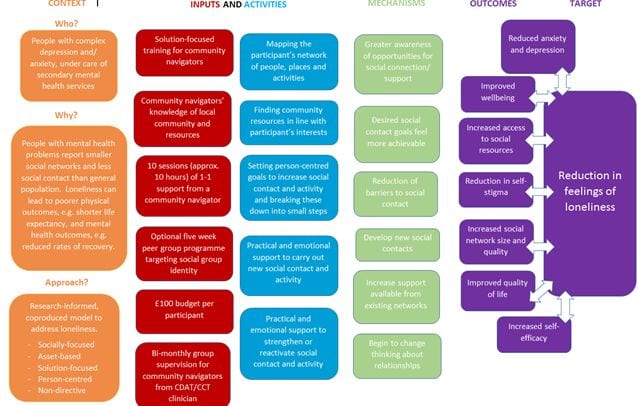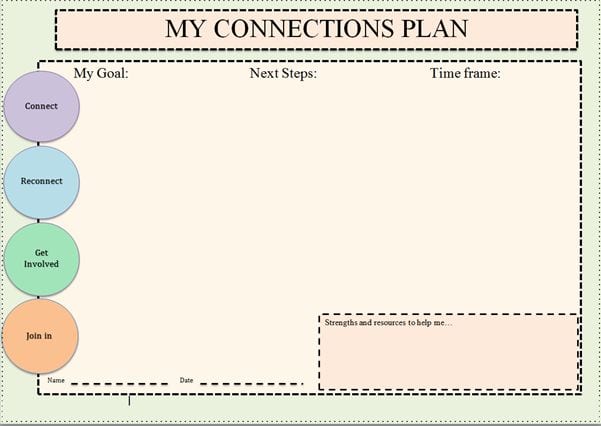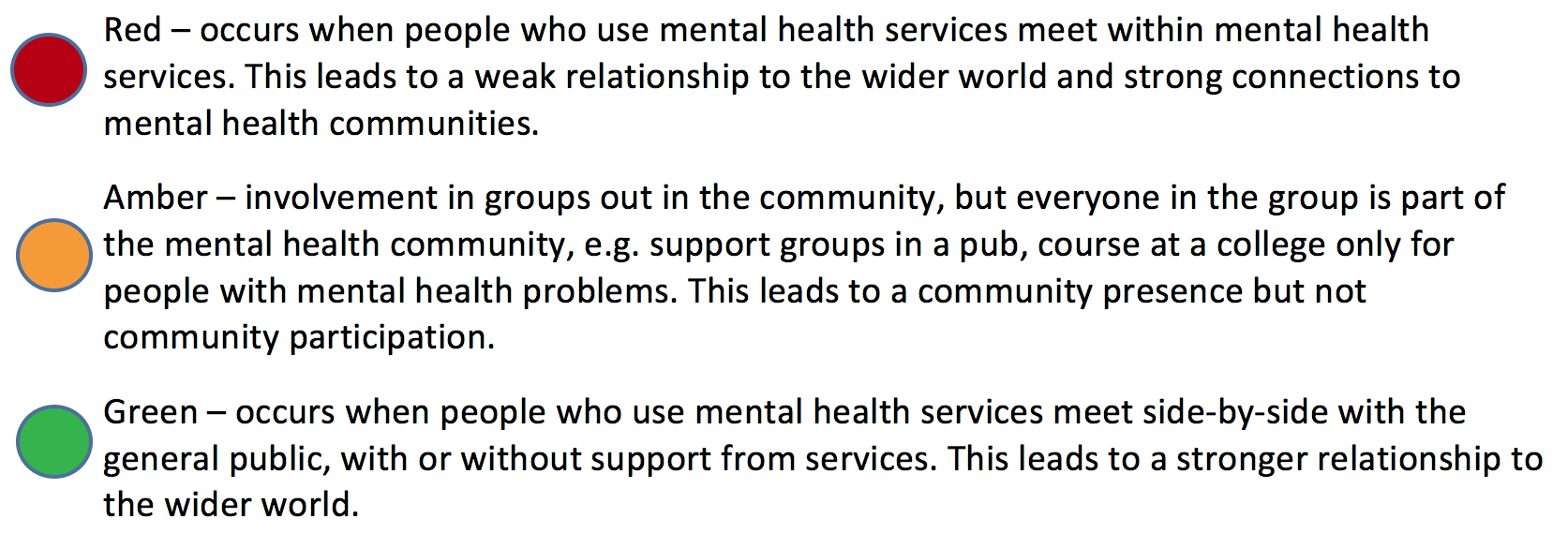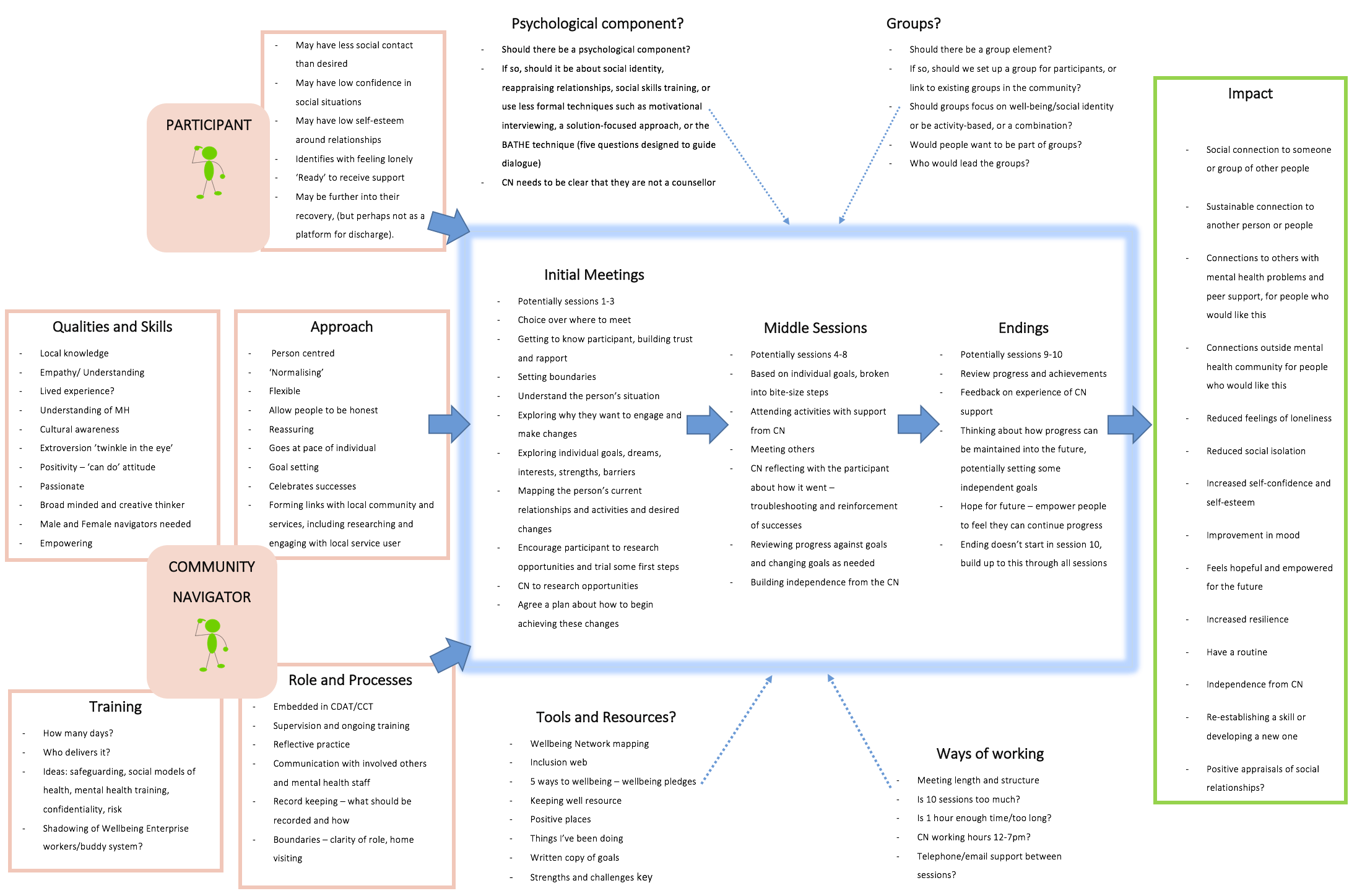Final development: Community Navigator Study Working Group Meeting 6
By Kate C Fullarton, on 31 August 2016
Our sixth meeting – the final one in the development phase of the study – began with one of our researchers, Johanna, giving an update on the recruitment of the community navigators. We have recruited three community navigators and we wish them a very warm welcome to the team. We then had a quick look at a draft of the community navigator manual, which provides an overview of the study, the support programme and the community navigator role, and asked the group for feedback. We will be able to share the manual once it is finalised so keep your eye on our project news for updates.
We then turned our attention to the Theory of Change that we have been developing over the course of the working group meetings, through the evolving models, which you can see on our blogs from weeks 1, 2 and 3. The aim of a Theory of Change is to provide a visual description of the process through which the support programme leads to the desired outcome, in this case, a reduction in loneliness. This Theory of Change will develop through the study, as we seek feedback from the community navigators, people receiving their support, and other people involved in the study. Below, you can see the latest draft of our Theory of Change. What do you think? Does this capture how you think the community navigator programme might work?

One of our experts by experience then introduced the latest plan for the community navigator training. The community navigators will receive five days of training specific to their new roles. The planned training days are jam-packed and will be delivered by members of the research team, clinicians from the CCT and CDAT team, experts by experience and navigation experts from Wellbeing Enterprises. We also discussed the importance of allowing space for community navigators to reflect on their existing strengths, learn from each other, and guide us about what they want to get from the training, and we’ll make sure this is incorporated into the training.
The study’s project manager, Bryn, then asked the group if, and how, they would like to be involved in delivering the training. Ideas included input from clinicians about the client group and their social needs and pairing community navigators with members of the working group with lived experience of mental health problems to try out some of the components of the programme, such as the mapping exercise and goal setting. This would give community navigators an opportunity to practice their skills and to get insights from the experts by experience about what they think works well. It was also suggested that providing the community navigators with techniques to help overcome setbacks should be incorporated into the training, and we’ll be adding this before training begins in September. We then split into groups to think of scenarios to use throughout training, which will help the community navigators to think through exactly how they would go about supporting a range of people with different interests and needs.
After a much needed coffee break, we came back to revisit the mapping tool, which we looked at initially in week 3. Johanna asked the group to discuss the following questions regarding the mapping tool, which is shown below:
- Are we just mapping people or people, places and activities?
There was general consensus that people, places and activities should be included in the mapping process.
- What is the time frame we are mapping?
The group agreed it would be useful to include present, past and future relationships if they are relevant to the individual the community navigator is supporting. A member of the group suggested that the community navigator begins the mapping activity by asking about present relationships, but considers past and future in their approach.
- Are we rating positive/negative impact of people/places/activities like the McPin Foundation do with their Wellbeing Maps or are avoiding rating and mapping closeness?
There was general consensus that it would not be useful to categorise relationships as positive or negative in this study as we are adopting a solution-focused approach, and that neutral colours should be used throughout the document to ensure that this does not happen.
- When would the tool be used? Just at the beginning or throughout or again at the end?
The group suggested that it might be interesting for the participants to compare a map completed at the beginning of the study to their map at the end. However, most importantly, people felt that the map should be used flexibility, depending on what the individual thought would be useful for them.

We then also returned to the goal setting tool, which we looked at in previous meetings. We considered four example tools, produced by our researcher Kate, which were inspired by Wellbeing Enterprises’ ‘Five ways to Wellbeing’ pledge tool. The ‘My Connections Plan’ shown below, with some minor changes, was the group’s preference. This was because it includes a section on ‘Strengths and resources to help me’ to remind people of their assets, as well as a ‘Time frame’ section, to give people an end-point to aim for with each goal. Can you think of any ways that you’d improve this plan further? Get in touch and let us know!

After a very productive meeting we briefly reflected on how much we have achieved as a group over only a few months. We also said goodbye to our research Kate, and we look forward to welcoming Jessica Bone on 1st September. Our next working group meeting will be early next year, and we expect the community navigators will join us to feed back on what it is actually like working in the role. Now, it’s time to finalise the manual, train the community navigators and recruit the participants for community navigators to work with!
Get in touch with Jess via jessica.bone.15@ucl.ac.uk if you have any thoughts about the study or follow us on Twitter @ucl_loneliness.
 Close
Close



